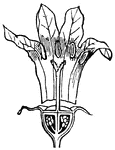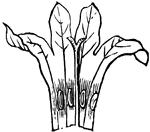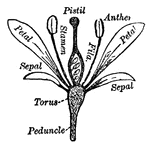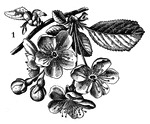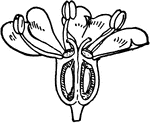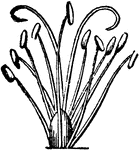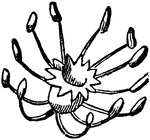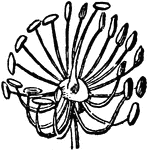The Flower Anatomy ClipArt gallery includes 418 illustrations of the parts of a flower.
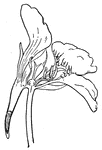
Cross-section flower
Flower of nasturtium cut through the middle to show the spur (s) and the nectar (n).
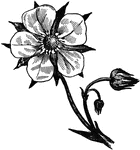
Perfect flower
"Contains both stamens and pistils, and the flowers are said to be perfect." —Fuller, 1910

Flowering Rush
A European plant which grows in stagnant or nearly stagnant water. It has long, sword-shaped leaves,…
Form of Stamen
This illustration shows a form of a stamen, the part of a flower that holds pollen for reproduction.

Form of Stamen
This illustration shows a form of a stamen, the part of a flower that holds pollen for reproduction.

Form of Stamen
This illustration shows a form of a stamen, the part of a flower that holds pollen for reproduction.

Fritillary
"Diagram of the symmetrical trimerous flower of Fritillary, having three divisions of the two outer…

Ovary of Frost Weed
Cross section of the ovary of Frost-Weed (Helianthemum), with three parietal placenta, bearing ovules.

Fructification of Carrot Flower
An illustration of fructification of the carrot flower. Fructification is a term used in the plant morphology…

Fruit Receptacle
Composite, or compound flowers, form the largest of all botanical orders. 3, receptacle with fruit adhering.
Fumitory Flower Anther
An illustration of a fumitory flower anther. Fumaria is a genus of about fifty annual herbaceous flowering…
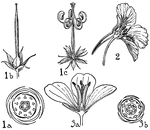
Orders of Geraniaceae, Tropaeolaceae, and Linaceae
Pictured are the orders of geraniacea, tropaeolaceae, and linaceae. The flowers of these orders that…
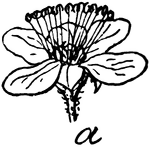
Hardhack Flower
Spiraea tomentosa. Also called Steeplebush and Meadowsweet, this plant grows up to four feet high. This…

Hawthorn Blossom
Hawthorn-blossom in section; parts adnate to whole face of ovary. and with each other beyond; another…
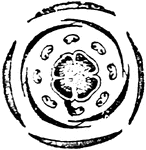
Heath
"Diagram of the flower of Heath (Erica), have four sepals, four divisions of the corolla, eight stamens…

Orders of Hypericaceae, Guttiferae, and Tamaricaceae
The orders of hypericacea, guttiferae, and tamaricaceae are pictured. The flowers of these orders that…

Hypericum
"Hypericum floribundum; 1. an entire flower; 2. a bundle of stamens; 3. a pistil with 3 carpels; 4.…
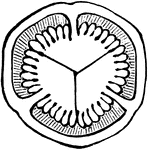
Hypericum graveolens
Cross-section of an ovary of Hypericum graveolens, the three large placenta meeting in the centre, so…
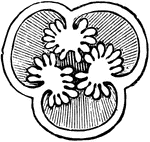
Hypericum graveolens
Cross section of an ovary of Hypericum graveolens with the placentae now separate and rounded.
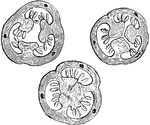
Three Cross Sections From Ovary of Hypericum Hirsutum
Pictured are three cross sections from the ovary of hypericum hirsutum. A is from the upper part, B…
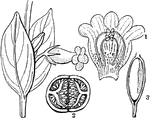
Hypocyrta
"Hypocyrta gracilis. 1. section of a flower; 2. cross section of a fruit; 3. seed with it embryo exposed…
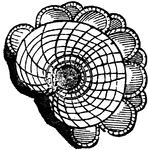
Indusium
A term used in botany referring to a case when a collection of hairs unite to form a cup inclosing the…

Iris
"Diagram of the trimerous symmetrical flower of Iris. There are three alternating divisions of each…
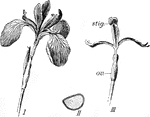
Iris
"Iris. I, flower; II, seed, longitudinal section; III, flower with outer segments of perianth removed;…
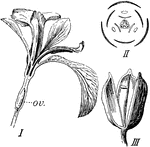
Iris
"Iris. I, flower, longitudinal section, ov., ovary; II, diagram, showing stigmas opposite the stamens;…
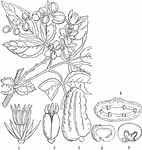
Lardizabala
"Lardizabala triternata. 1. petals and stamens of male flower; 2. carpels; 3. fruit of a Lardizabala;…
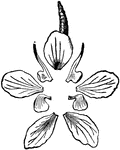
Larkspur
Its calyx and corolla displayed; the five large parts are the sepals; the four smaller, of two shapes,…

Orders of Lecythidaceae, Rhizophoraceae, Combretaceae, Myrtaceae, and Melastomaceae
Pictured are the orders of Lecythidaceae, Rhizophoraceae, Combretaceae, Myrtaceae, and Melastomaceae.…

Leptolaena
"Leptolaena multiflora. 1. a perpendicular section of its flower; 2. a diagram of its structure; 3.…
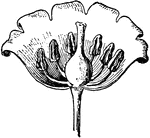
Section of Lily-of-the-Valley
Illustrated is a section of the flower of lily-of-the-valley. It is laid open to show the parts.
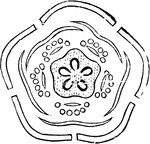
Linden
Diagram of a flower of Linden, showing the calyx valvate and corolla imbricate in the bud, etc.
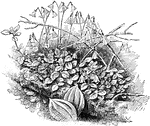
Linnaea Borealis
Linnaea borealis is a variety of twin flower. It is native to northern Europe and northern Asia. The…
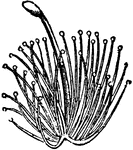
Linnaeus' Polyandria
The sexual system of a plant, here having many stamens with a pistil in the center, Polyandria.

Linnaeus' Didynamia
The sexual system of a plant, here having four stamens of unequal length, Didynamia.

Linnaeus' Tetradinamia
The sexual system of a plant, here having six stamens (four longer), Tetradinamia.

Linnaeus' Monadelphia
The sexual system of a plant, here having stamens united in a tube, Monadelphia.
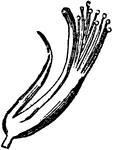
Linnaeus' Diadelphia
The sexual system of a plant, here having stamens united in two bundles, Diadelphia.

Linnaeus' Polyadelphia
The sexual system of a plant, here having stamens united in three or more bundles, Polyadelphia.

Linnaeus' Syngenesia
The sexual system of a plant, here having stamens united by anthers, Syngenesia.
